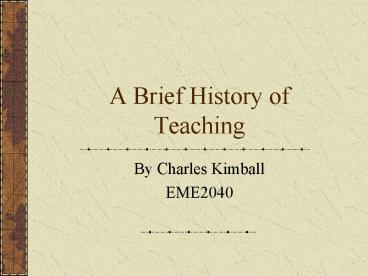A Brief History of Teaching PowerPoint PPT Presentation
1 / 17
Title: A Brief History of Teaching
1
A Brief History of Teaching
- By Charles Kimball
- EME2040
2
- For thousands of years, methods of instruction
didnt change much. - In fact, most of the changes have taken place
since 1900.
3
The oldest forms of writing took many years to
learn.
Hieroglyphics
Cuneiform
4
And the teaching methods werent very friendly,
either.
- Babylonians called a teacher the one in charge
of the whip. - Egyptians liked to say that a boys ears are on
his back.
5
But if you could learn in school, it was worth it.
- Back then, less than 10 percent of the people
knew how to read and write. - That meant good jobs for those who graduated.
6
Then the alphabet replaced hieroglyphics
cuneiform.
- However, learning to read was still a challenge.
Why?
7
Because at this stage writing didnt have many of
the features that help us to understand it, like
- Punctuation.
- Spaces between the words.
- Lower-case letters.
- Sometimes it wasnt even clear which direction
the words should be read in.
8
How quickly do you think you can read something
like this?
9
- In addition, most writing in medieval Europe was
done in Greek or Latin, not the languages people
learned as children. - Medieval monks added spaces and lower-case
letters to the manuscripts they copied, once they
were convinced that this didnt waste space.
10
Even so, books were very expensive.
- The average noble might have twenty books in his
library, and only the Church could afford more
than that. - The high price was caused by the amount of work,
and expensive materials it took about 300
sheepskins to make enough parchment for one Bible.
11
Three inventions during the Renaissance made
books easier to make, and easier to understand
- Paper.
- The printing press.
- Standardized forms of modern languages (Italian,
German, English, French and Spanish).
12
John Amos Comenius
- Lived in what is now the Czech Republic,
1592-1670. - Nicknamed The Incomparable Moravian.
- Introduced textbooks with pictures in them.
13
18th 19th Century Innovations
- A few widely used textbooks, like the New England
Primer (1700s) and the McGuffey Reader (1840s). - Wall charts (1826).
- Models (1855).
- Kindergarten, developed by Friedrich Froebel
(1837) and Maria Montessori (1901).
14
Early Steps in the Audiovisual Movement
- Educational museums (1904).
- Educational films (1911).
- Instruction by radio (1929).
- Multi-media training (1945, for the armed
forces). - Educational TV (1953).
- Programmed instruction (1957).
15
Developments In My Lifetime
- PBS (1967).
- Apple makes the first personal computer (1977).
- Computer-assisted instruction (1980s).
- CD-ROMs, teleconferencing, the Internet, virtual
reality (1990s). - And theres much more on the way!
16
- Another PowerPoint presentation by Charles
Kimball. - To view more like it, visit the Technology For
Educators HQ.
17
(No Transcript)

